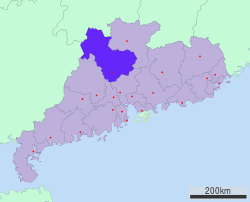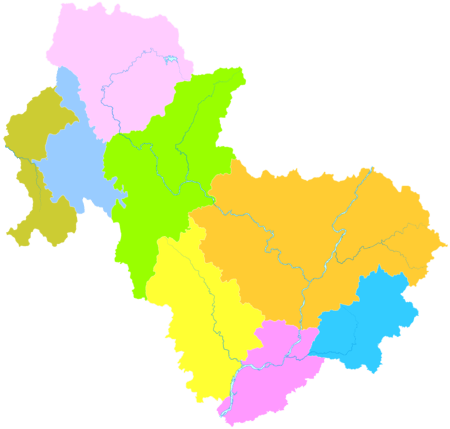Qingyuan
| Qingyuan 清远市 | |
|---|---|
| Prefecture-level city | |
|
| |
 Location of Qingyuan in Guangdong | |
 Qingyuan Location in China | |
| Coordinates: 23°49′N 113°02′E / 23.817°N 113.033°E | |
| Country | People's Republic of China |
| Province | Guangdong |
| County-level divisions | 9 |
| Township-level divisions | 53 |
| City seat | Qingcheng District |
| Area | |
| • Prefecture-level city | 19,152.9 km2 (7,395.0 sq mi) |
| • Urban | 3,652.3 km2 (1,410.2 sq mi) |
| • Metro | 3,652.3 km2 (1,410.2 sq mi) |
| Elevation | 14 m (45 ft) |
| Population (2010 Census[1]) | |
| • Prefecture-level city | 3,698,412 |
| • Density | 190/km2 (500/sq mi) |
| • Urban | 1,510,044 |
| • Urban density | 410/km2 (1,100/sq mi) |
| • Metro | 1,510,044 |
| • Metro density | 410/km2 (1,100/sq mi) |
| Time zone | China Standard (UTC+8) |
| Area code(s) | (+86) 0763 |
| Licence Plate | 粤R |
| Major Nationalities | Han, Zhuang and Yao. |
| Website | http://www.gdqy.gov.cn/ |
| Qingyuan | |||||||||||||||||||||||
|
"Qingyuan" in Chinese | |||||||||||||||||||||||
| Simplified Chinese | 清远 | ||||||||||||||||||||||
|---|---|---|---|---|---|---|---|---|---|---|---|---|---|---|---|---|---|---|---|---|---|---|---|
| Traditional Chinese | 清遠 | ||||||||||||||||||||||
| Cantonese Yale | Chīngyúhn | ||||||||||||||||||||||
| Cantonese Jyutping | Cing1-jun5 | ||||||||||||||||||||||
| Hanyu Pinyin | Qīngyuǎn | ||||||||||||||||||||||
| Postal | Tsingyun | ||||||||||||||||||||||
| Literal meaning | Clear-&-Distant | ||||||||||||||||||||||
| |||||||||||||||||||||||
Qingyuan, formerly romanized as Tsingyun,[lower-alpha 1]</ref> is a prefecture-level city in northern Guangdong, China, on the banks of the Bei or North River. During the 2010 census, its total population was 3,698,412, out of whom 1,510,044 lived in the urbanized Qingcheng and Qingxin districtss. The primary spoken language is Cantonese. Covering 19,015 km2 (7,342 sq mi), Qingyuan is Guangdong's largest prefecture by land area. The urban core is surrounded by mountainous areas but is directly connected with Guangzhou and the Pearl River Delta by Highway 107.
History
Under the Qing, the area was known as Qingyuan County.[4] It was later promoted to prefecture-level city status.
Geography
Qingyuan's administrative area ranges in latitude from 23° 31' to 25° 12' N, and in longitude from 111° 55' to 113° 55′ E, just north of the Tropic of Cancer and about 200 km (120 mi) from coast of the South China Sea. More than half of the area is mountainous, and elevations increase from southeast to northwest.
Qingyuan has a monsoon-influenced humid subtropical climate, with an average annual temperature of 20.7 °C (69.3 °F), 1,900 mm (75 in) of rainfall, 1662.2 hours of sunshine, and a frost-free period of 314.4 days.[5]
Economy
Qingyuan is a major economic and transportation hub. The Beijing–Guangzhou Railway, National Highways 106 and 107, and the Bei or North River cross through the city. The maritime infrastructure in Qingyuan plays a vital role in transporting goods to other regional centers in Guangdong, Hong Kong, and Macao. The major ports are Qingyuan Port, Yingde Port, Lianzhou Port, and Yangshan Port.
Demographics
According to the 2010 Census, Qingyuan has a population of 3,698,394 inhabitants,[6] 550,715 more than in 2000 (an annual growth rate of 1.63%). Han Chinese comprise over 95% of the entire population, while there are some areas inhabited by the Zhuang and Yao minorities.
Attractions
Qingyuan is famous for its tourist attractions. These include Niuyuzui, Feilai Temple, Feixia Scenic Spots, Baojing Palace of Yingde, Taihe Ancient Cave of Qingxin, Sankeng Hot Spring in Qingxin County, Huanghua Lake in Fogang, Little Biejiang of Lianyang, Peak Shikengkong in Yangshan County, Underground River of Lianzhou, Huangteng Gorge, Three Gorges of Huangchuan, Yinzhan Hot Spring Area, and the indigenous customs of minorities in Liannan and Lianshan.
Administration
The provincial and municipal administration is located in Qingcheng District. It oversees one other district, two county-level cities, four counties, and one economic development district.
| Map | |||||
|---|---|---|---|---|---|
| Name | Simplified Chinese | Hanyu Pinyin | Population (2010 census) |
Area (km2) |
Density (/km2) |
| Qingcheng District | 清城区 | Qīngchéng Qū | 811,233 | 927.22 | 875 |
| Qingxin District | 清新区 | Qīngxīn Qū | 698,811 | 2,725.07 | 256 |
| Fogang County | 佛冈县 | Fógāng Xiàn | 302,906 | 1,292.92 | 234 |
| Yangshan County | 阳山县 | Yángshān Xiàn | 356,095 | 3,418.37 | 10' |
| Lianshan Zhuang and Yao Autonomous County |
连山壮族 瑶族自治县 |
Liánshān Zhuàngzú Yáozú Zìzhìxiàn |
90,515 | 1,164.84 | 78 |
| Liannan Yao Autonomous County |
连南瑶族 自治县 |
Liánnán Yáozú Zìzhìxiàn |
129,258 | 1,239.38 | 100 |
| Yingde | 英德市 | Yīngdé Shì | 941,952 | 5,671.02 | 166 |
| Lianzhou | 连州市 | Liánzhōu Shì | 367,642 | 2,664.09 | 138 |
Notes
References
Citations
- ↑ http://www.citypopulation.de/php/china-guangdong-admin.php
- 1 2 Encyclopaedia Britannica, 9th ed. (1878), Vol. V, "China".
- ↑ Encyclopaedia Britannica, 11th ed. (1911), Vol. XV, "Kwang-tung".
- ↑ Gutzlaff (1838), p. 564.
- ↑ 清远 - 气象数据 -中国天气网 (in Chinese). Weather China. Retrieved 2012-07-18.
- ↑ (Chinese) Compilation by LianXin website. Data from the Sixth National Population Census of the People's Republic of China Archived April 6, 2012, at the Wayback Machine.
Bibliography
- Gutzlaff, Charles (1838), China Opened, or, A Display of the Topography, History, Customs, Manners, Arts, Manufactures, Commerce, Literature, Religion, Jurisprudence, Etc. of the Chinese Empire, Vol. II, London: Smith, Elder, & Co..
External links
| Wikivoyage has a travel guide for Qingyuan. |
| Wikimedia Commons has media related to Qingyuan. |

